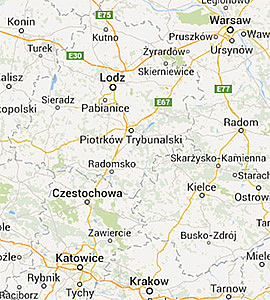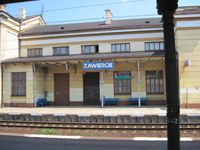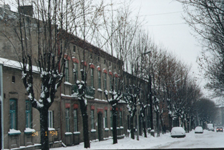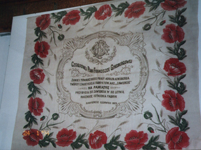Kromołów is the oldest section of Zawiercie. It is 4 miles east of Zawiercie. The first reference to Kromołów is from 1193. In the 12th Century Kromołów was a village. Kromołów became a district of Zawiercie in 1975. A detailed time line of the history of Kromołów appears in Polish in the Portal Kromołowa.
The Zawiercie Ironworks is mentioned in 1431 and the Zawiercie village is mentioned in 1492.
Throughout its history, Zawiercie changed hands countless times. The first owner recorded in documents from 1490 was Jan Pilecki. Two years later the village passed to Jan Feliks Rzeszowski – canon at Krakow. Later, Zawiercie belonged to the rich and powerful Boner family and was then transferred to the Firlejs, a noble Polish family, for almost 100 years, until 1669.
In 1669 Mikołaj Firlej sold Zawiercie together with Kromołów and several other places to Stanisław Warszycki (1600-1680) who had been the provincial governor of Mazovia since 1630. Zawiercie was then transferred to the Męciński counts, then to Konstanty Gostkowski, and to General Lieutenant Fryderyk Wielki II. In 1820 Zawiercie was purchased by a Wrocław banker - Pingsheim.
Written sources from 1827 mention two names for Zawiercie: the Small Zawiercie and the Big Zawiercie. Small Zawiercie belonged to the Kromołów community, and Large Zawiercie belonged to the Mrzygłód community. The settlements were marked that way on maps until 1914.
In 1887 there were 5.200 people and that number increased to 35.000 citizens by 1914. This increase was the result of the geographical location of Zawiercie and the development of industry. However, the key role in the town’s development was the building of the Warsaw-Vienna railway in the second part of the 19th century. On December 1, 1847, the first train came to the village. The first wooden station building was erected in 1872. The brick building was built about twenty years later, in 1890. The present building was built in the years 1910-1913, and it was intended to celebrate the 300th anniversary of the reign of the Romanov dynasty in Russia. Building Pilica-Siewierz Road also had an influence on the town economic development. The sub-chapter “The Coming of the Railway” in Social and Political History of the Jews in Poland, 1919-1939 by Joseph Marcus tells the story of the railway, its significance and its contribution to Poland’s development.
The beginning of cotton industry has been dated from the early years of the 19th century. In 1830 the first cotton spinning mill was established in Zawiercie – at present it is “Zawtex” Cotton Industry Works. On August 9, 1869, the brothers Bernard, Adolf and Wilhelm Ginsberg, Jewish bankers from Berlin, bought a cotton factory in Kromołów. Thus the Ginsberg brothers created the foundation for the development of their great enterprise of cotton. Other Ginsberg brothers were heavily involved in the cotton industry and raw textile materials in Lodz.
The Ginsberg brothers are credited with creating the "Zawiercie Incorporated Company". The textile works of the Ginsberg brothers - TAZ ranked among the biggest in the 19th century Kingdom of Poland. In 1878, construction of a settlement for workers was initiated, with schools, parks and churches. Workers had their own housing estates, school, community center and a hospital. The Ginsberg brothers also invested in building a Roman Catholic Church in Zawiercie. The project was the first planned and well organized multifamily housing estate with public buildings. The Ginsberg brothers had a strong influence on the town economic development.
During WWII, the factory produced overalls for the pilots of the Nazi Luftwaffe. After the war, the Polish government nationalized the factory. The sub-chapter “The Textile Industry” in the above-mentioned Joseph Marcus book tells the story of this largest industry in Poland.
In 1880 John Matthew Sambor and Marcin Krawczyk founded a metal manufacturing company which began production of power transmission elements for spinning and weaving mills as well as other parts. The name of the company was Zawiercie Machinery Factory or "ZAFAMA."
In 1910 the same factory became the sole property of the Krawczyks family and adopted the name "Factory Power Transmission, Machinery, and Iron Foundry Krawczyk i S-ka" in Zawiercie. In 1919 the factory was bought by Eng. Banachiewicz Ignatius, who changed the name of the factory to "Label Machines in Zawiercie Eng. I. Banachiewicz i S-ka". The factory was nationalized in 1946 and went through more changes through the years. It still exists today as ZAFAMA.
Ernest Erbe, who was the ancestor of a Lutheran German Family of Erbe, came to Zawiercie in 1886. He started with a small iron factory, employing 10 people. In 1892, his forge was one of the first in Poland to start producing cast-iron. At the turn of the 20th century, both the output and the employment of the enterprise grew considerably (48 employees in 1898, 270 in 1909), and its products found purchasers all over the European part of the Russian Empire. In 1918 the business came under the ownership of Ernst's son, Alexander. In independent Poland the factory prospered, excluding the 1929-1935 period of depression. It was a major exporter of cast-iron, selling its products to Germany, Britain, Belgium, Peru, India and many other countries, and employing up to 600 people.
During the Nazi occupation in the years 1939-1945, the factory was still in the possession of Alexander Erbe and it worked for the 'Wehrmacht'. In 1946, the factory was nationalized. After Zawiercie was liberated from the German occupation, the Erbe family was arrested. Alexander died in prison in 1945. His wife and son were released and rehabilitated, and later moved to Warsaw, where their descendants have been living until today.
More information about the Erbe family and the Iron Factory can be found in the book:
Odlewnia Żeliwa Ciągliwego i Wytwórnia łączników w Zawierciu
(1886-1986) by Longina Rosikona |
Zawiercie Crystal Glass Factory is one of the most renowned crystal glass manufacturers in Poland. The company is steeped in history and the handmade manufacturing process it uses distinguishes its products and makes them easily recognizable, with original patterns that could not be obtained through mass production techniques.
The history of the Zawiercie Glass Factory is linked to the glass factory of S. Reich & Co that was founded in 1813 by Samuel Reich in the town of Krasna, Czechoslovakia, and rapidly established itself to become one of the leading family-run glass factories in Europe.
Glass products had been manufactured in the Zawiercie region for hundreds of years before S. Reich and Company took over the existing factory in 1884, creating a modern industrial plant. Zawiercie products are sold worldwide -- to Europe, the USA, Africa, Australia, and throughout Asia. In 1998 the factory was turned into a publically held company, which continued the tradition of glass and crystal manufacturing in Zawiercie. In 2009, after a period of insolvency, the factory was bought by new owners.
In 2002 when I visited the Zawiercie cemetery, the cemetery guard searched a small neglected building while my sister and I stood at the door watching him through the darkness. He presented us with two crystal wine glasses and mumbled something we unfortunately didn’t understand. When I surfed through the Zawiercie Crystal Glass Factory website, I realized the glasses had the same style.

In 1898 there were four elementary schools in Zawiercie: one community school, a TAZ school, a Reich Glassworks school, and one railway school. In the following years several private schools were opened. One of them was Helena Malczewska girls' boarding school. In 1907 Józef Meyer’s male pre-grammar school started its teaching, and in 1913 Wanda Karczewska’s female grammar school opened. In 1934 a co-educational trade school was created by the Polish Merchants’ Association.
After 1927, elementary and community schools became nationalized and converted into public ones. A polytechnic school opened. In 1939 the following schools existed in Zawiercie: 6 elementary schools, boys’ grammar school, a girls’ grammar school, a trade co-educational school, and public co-educational grammar school.
Between WWI and WWII there were 4 cinemas in Zawiercie. In 1933 the puppets’ theatre "Baj-Baju" was created. At that time the Municipal Park - one of the most beautiful parks in the Dąbrowa Basin – became public.
Until 1903 Zawiercie belonged to the Kromołów Parish. In 1900 the building of Neo-Gothic Parish Church was dedicated to St. Paul and Peter Apostles. It was built by TAZ Management, a building committee, and Zawiercie workers. The engineer Hugon Kudera completed the project. The Zawiercie Parish has belonged to the Częstochowa Diocese since 1925. Choir "Lira", which in 1925 won the first prize among male choirs at Province Congress in Kielce, was active in the parish.
Canon Priest Bolesław Wajzler was the last parish-priest before outbreak of World War II. He was known here as a social worker and a worthy professor at the local female teachers' college. He was murdered in Auschwitz Camp. A Catholic cemetery was set up in 1903, and in 1920 it was considerably extended.
In the 19th century a Jewish community existed in Zawiercie and the orthodox Jewish influences were very strong. In 1880 one synagogue was built at Marszałkowska Street, and a Jewish community house was next to it. There are still monumental Jewish cemeteries in Kromołów and at Daszyńskiego Street in Zawiercie. The Jewish cemetery in Kromołów is from the 18th century; it is situated near the road running to the Zawiercie center. In the cemetery there are many tombstones with inscriptions from the 18th and 19th centuries. A complex of Jewish tenements houses has been preserved until now at Marszałkowska and Hoża Streets. There is more about the history of the Zawiercie Jewish Community in the chapter by this name.
After the end of the WWII, Zawiercie recovered and then started to develop quite rapidly.
|






